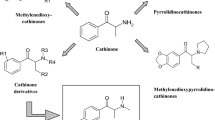Abstract
α-Pyrrolidinovalerophenone (α-PVP) is a synthetic derivative of the cathinone, which is one of the most popular new psychoactive substances (NPSs) in Poland in recent years. α-PVP was found in blood in 66 cases sent to the Institute of Forensic Research during a one-and-a-half-year period, from the beginning of 2014 to the middle of 2015 (since 1 July 2015 α-PVP has been controlled). α-PVP was found in 26 cases in 2014 and in 40 cases in 2015. The cases were related mainly to driving under the influence of drugs (DUID), traffic accidents, acts of violence, as well as intoxications and deaths. In most of the cases (42 out of 66), other substances were also detected, including NPSs and other common drug(s) of abuse. Analyses of blood for α-PVP were carried out using liquid chromatography–tandem mass spectrometry. The determined concentrations of α-PVP ranged from traces (<1 ng/mL) up to 6200 ng/mL (mean concentration 140 ng/mL, median 27 ng/mL). The ranges in specific type groups of cases were as follows: DUID, 6.4–99 ng/mL; traffic accidents, 10.2–30 ng/mL; drug possession, <1–98 ng/mL; non-fatal intoxication, 1.2–56 ng/mL; deaths, 1.1 ng/mL to 6200 ng/mL; and others, 2.6–136 ng/mL. Symptoms of α-PVP action were also studied. The effects of impairment were notable in a wide range of concentrations, but 40 ng/mL was proposed as the cutoff value for predicting significant influence of α-PVP on psychomotor performance. Intoxication cases indicated that recreational use of α-PVP involves significant health risks and is sometimes fatal.


Similar content being viewed by others
References
EMCDDA (2015) Europol Joint Report on a new psychoactive substance: 1-phenyl-2-(1-pyrrolidinyl)-1-pentanone (α-PVP). http://www.emcdda.europa.eu/attachements.cfm/att_242501_EN_TDAS15001ENN.pdf. Accessed 15 Nov 2015
Eiden C, Mathieu O, Cathala P, Debruyne D, Baccino E, Petit P, Peyriere H (2013) Toxicity and death following recreational use of 2-pyrrolidino valerophenone. Clin Toxicol 51:899–903
Kaizaki A, Tanaka S, Numazawa S (2014) New recreational drug 1-phenyl-2-(1-pyrrolidinyl)-1-pentanone (alpha-PVP) activates central nervous system via dopaminergic neuron. J Toxicol Sci 39:1–6
Aarde SM, Creehan KM, Vandewater SA, Dickerson TJ, Taffe MA (2015) In vivo potency and efficacy of the novel cathinone α-pyrrolidinopentiophenone and 3,4-methylenedioxypyrovalerone: self-administration and locomotor stimulation in male rats. Psychopharmacology 232:3045–3055
Marusich JA, Antonazzo KR, Wiley JL, Blough BE, Partilla JS, Baumann MH (2014) Pharmacology of novel synthetic stimulants structurally related to the “bath salts” constituent 3,4-methylenedioxypyrovalerone (MDPV). Neuropharmacology 87:206–213
Gatch MB, Dolan SB, Forster MJ (2015) Comparative behavioral pharmacology of three pyrrolidine-containing synthetic cathinone derivatives. J Pharmacol Exp Ther 354:103–110
Knoy JL, Peterson BL, Couper FJ (2014) Suspected impaired driving case involving α-pyrrolidinovalerophenone, methylone and ethylone. J Anal Toxicol 38:615–617
Naylor JE, Freeman KB, Blough BE, Woolverton WL, Huskinson SL (2015) Discriminative-stimulus effects of second generation synthetic cathinones in methamphetamine-trained rats. Drug Alcohol Depend 149:280–284
Nagai H, Saka K, Nakajima M, Maeda H, Kuroda R, Igarashi A, Tsujimura-Ito T, Nara A, Komori M, Yoshida K (2014) Sudden death after sustained restraint following self-administration of the designer drug α-pyrrolidinovalerophenone. Int J Cardiol 172:263–265
Adamowicz P, Tokarczyk B (2015) Simple and rapid screening procedure for 143 new psychoactive substances by liquid chromatography–tandem mass spectrometry. Drug Test Anal. doi:10.1002/dta.1815
Uralets V, Rana S, Morgan S, Ross W (2014) Testing for designer stimulants: metabolic profiles of 16 synthetic cathinones excreted free in human urine. J Anal Toxicol 38:233–241
Maas A, Wippich C, Madea B, Hess C (2015) Driving under the influence of synthetic phenethylamines: a case series. Int J Legal Med 129:997–1003
Dragogna F, Oldani L, Buoli M, Altamura AC (2014) A case of severe psychosis induced by novel recreational drugs. F1000Research 3:21. doi:10.12688/f1000research.3-21.v1
Saito T, Namera A, Osawa M, Aoki H, Inokuchi S (2013) SPME–GC–MS analysis of α-pyrrolidinovaleorophenone in blood in a fatal poisoning case. Forensic Toxicol 31:328–332
Minakata K, Yamagishi I, Nozawa H, Hasegawa K, Wurita A, Gonmori K, Suzuki M, Watanabe K, Suzuki O (2013) MALDI-TOF mass spectrometric determination of four pyrrolidino cathinones in human blood. Forensic Toxicol 32:169–175
Sykutera M, Cychowska M, Bloch-Boguslawska E (2015) A fatal case of pentedrone and α-pyrrolidinovalerophenone poisoning. J Anal Toxicol 39:324–329
Hasegawa K, Suzuki O, Wurita A, Minakata K, Yamagishi I, Nozawa H, Gonmori K, Watanabe K (2014) Postmortem distribution of α-pyrrolidinovalerophenone and its metabolite in body fluids and solid tissues in a fatal poisoning case measured by LC–MS–MS with the standard addition metod. Forensic Toxicol 32:225–234
Author information
Authors and Affiliations
Corresponding author
Ethics declarations
Conflict of interest
There are no financial or other relations that could lead to a conflict of interest.
Ethical approval
All blood collections from suspected living and deceased subjects were made by judicial authorities, and the samples were sent to our Institute for toxicological analysis according to their request. Small amounts of α-PVP-free blood samples were collected from 20 healthy subjects after obtaining their informed consent.
Rights and permissions
About this article
Cite this article
Adamowicz, P., Gieroń, J., Gil, D. et al. Blood concentrations of α-pyrrolidinovalerophenone (α-PVP) determined in 66 forensic samples. Forensic Toxicol 34, 227–234 (2016). https://doi.org/10.1007/s11419-016-0306-0
Received:
Accepted:
Published:
Issue Date:
DOI: https://doi.org/10.1007/s11419-016-0306-0




